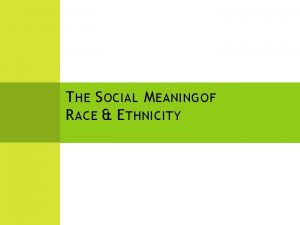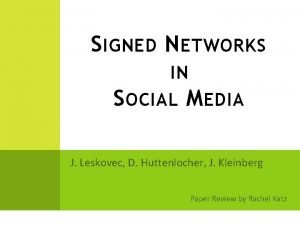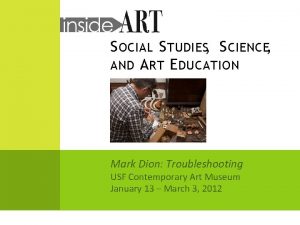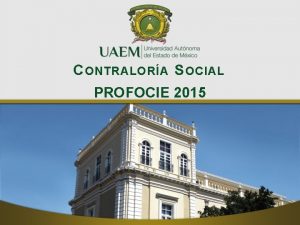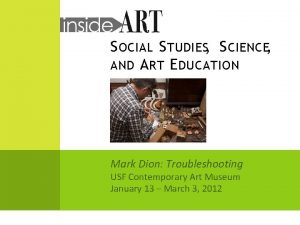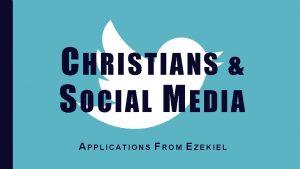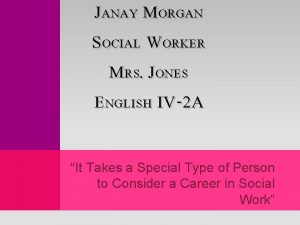T HE S OCIAL M EANING OF R





















































- Slides: 53

T HE S OCIAL M EANING OF R ACE & E THNICITY

R ACE Race – a socially constructed category of people who share biologically transmitted traits that members of society consider important Such As? Skin Color Hair Texture Facial Features Body Shape

R ACE Varies across time and place. We consider racial differences more important than other societies do. In the US we tend to “see” just 3 racial categories: white, black, and Asian. Other cultures are different (ex: Brazil). The Social Construction of Race: The US Census & Others Defined differently by different people within a society. Ex: Colorism Among African-Americans

B RAZIL E XAMPLE

R ACIAL T YPES Invented by scientists over 100 years ago to organize the world’s physical diversity. Initial categories were Caucasoid, Negroid, and Mongoloid. Misleading at best and harmful at worst.

R ACIAL H IERARCHY Knowing people’s race allows us to predict almost nothing about them, but societies still consider race very important. Why? Categories allow societies to rank people in a hierarchy. So it is all about stratification and the justification for stratification!

R ACIAL H IERARCHYOF N AZI G ERMANY

E THNICITY Ethnicity – a shared cultural heritage, which typically involves common ancestors, language, and religion Give people a unique social identity. Also socially constructed, only becoming important when society defines it that way. Race (biological) & ethnicity (cultural) do go hand-in-hand sometimes. US Society Hundreds of Ethnicities Is “American” an ethnicity?

M INORITIES Minorities – any category of people, identified by physical or cultural traits, that a society subjects to disadvantage Identity Power Minorities share a distinctive identity. Ability to blend in depends on the desire to hold on to traditions and the willingness of others to accept. Minorities are disadvantaged, receiving less schooling and lower-paying jobs. Not everyone in any minority category is disadvantaged. Fewer Numbers? Not as important anymore! Over 25% of the US population are a R or E minority. Majority minority in over ½ the 100 largest US cities and in 4 US states (Map on Next Slide).

I NTERRACIAL R ELATIONSHIPS Racial and ethnic categories are becoming increasingly diluted due to the increase in interracial relationships and child-bearing. Young people are more supportive of interracial relationships than older people. Trends in Interracial Relationships

WEB D U B OIS Early major theorist and advocate in the realm of race. The Color Line Cultural structure, internalized attitudes, separation Saw this as the most important issue of the 20 th Century

WEB D U B OIS The Souls of Black Folk Key Concepts: The Veil: Metaphor for barriers of race You are either within or outside the veil Double consciousness Living in two worlds- the black world and the white world Simultaneously outsiders and insiders (outsiders within)

U. S. is increasingly diverse, and this trend is projected to continue for decades

Racial, Ethnic Wealth Gaps Have Grown Since Great Recession

College enrollment

R ACIAL AND E THNIC C ATEGORIESIN THE U NITED S TATES, 2006 S O U R CE : U. S. C E NS U S B UR E AU, 2007




N ATIONAL M AP W H E R ET H E MINORITY MAJORITY ALREADY EXISTS

P REJUDICE & S TEREOTYPES

P REJUDICE Prejudice – any rigid and unfounded generalization about an entire category of people Prejudgement developed before interaction. Difficult to change. Positive vs. Negative Involve social class, gender, religion, age, political orientation, and sexual orientation. Most are based on race and/or ethnicity. Exs: Black people are lazy. Asians are smart. Stereotypes – an exaggerated description applied to every person in some category Rigid beliefs that are often at odds with reality. Typically negative, but not always. Ex: All black men are criminals. Stuff White People Like There are ethnic stereotypes as well.

M EASURING P REJUDICE Measuring Prejudice: The Social Distance Scale Bogardus (1925) – developed the social distance scale to measure prejudice among students at US colleges Asked students how closely they were willing to interact with people in 30 racial and ethnic categories. 7 Point Scale Marriage Barred from the Country On Next Slide

B OGARDUS S OCIAL D ISTANCE R ESEARCH

M EASURING P REJUDICE: R ESULTS Bogardus’ Results (1925): Parillo & Donoghue’s Results (2005): Found that people feel much more distance from some categories of people than from others. Most prejudiced against Latinos, African Americans, Asians, and Turks. Most accepting of the English, Scots, and Canadians. More accepting of all minorities. See less difference between the various minorities. Increased prejudice against Arabs and Muslims. Another Modern Study

R ACISM Racism – the belief that one racial category is innately superior or inferior to another Why is racism so widespread? Because the claim that people are biologically inferior can be used to justify making them socially inferior. Past: Colonization & Slavery Present: Hate Groups Institutional Racism – racism at work in the operation of social institutions, including the economy, schools, hospitals, the military, and the criminal justice system Prejudice is institutional when attitudes are part of the society’s culture so that there’s a widespread pattern. Ex: The belief inherent in the CJS that minorities are more likely to commit crimes.

D ISCRIMINATION

D ISCRIMINATION What’s the difference between prejudice and discrimination? Discrimination – the unequal treatment of various categories of people Prejudice = Attitudes / Discrimination = Actions Can be positive (+) or negative (--). Ruling out an entire category of people is wrongful discrimination and it is illegal. Ex: Only interviewing applicants that have “Asian-sounding” names for a job opening. Race & Crime Institutional Discrimination – discrimination that is built into the operation of social institutions, including the economy, schools, and the legal system Ex: The widespread practice among police of pulling people over for DWB, “driving while black. ” Ex: News Coverage of Crime Victims

V ICIOUS C YCLE Prejudice & Discrimination: A Vicious Circle Thomas Theorem at work! Prejudice and discrimination reinforce each other. Police Example

C ONSEQUENCESOF P&D What are they? Class Standing Wealth Gap Types of Jobs Available Joblessness The link between race & class is so strong that the two are often conflated (become fused). Health Outcomes Childhood Asthma Infant Mortality Birth Rate

C ONSEQUENCESOF P&D Beliefs About Self Tokenism Orientalism Objectification of the Native via Tourism Fetishization Doctoring Diversity Black Top Chefs Commodification Racism in Toyland Fethishization of the Black Body Exclusion from Media & Public Life Cast of Glee on Cover of Rolling Stone Left Out of Politics

P ATTERNS OF M AJORITYM INORITY I NTERACTION

P ATTERNS OF M AJORITYM INORITY I NTERACTION 1. Genocide – the systematic killing of one category of people by another 1500 s+: Colonization 1930 s & 1940 s: Nazis in Germany & Stalin in Russia Late 1970 s: Cambodia Present: Hutus massacre of the Tutsis in Rwanda; Serbs murders of the Croats in E. Europe; Darfur in Sudan 2. Segregation – the physical and social separation of categories of people Sometimes minorities self-segregate, but usually the majority segregates minorities by forcing them to the margins of society. De Jure (by law) vs. De Facto (in fact) Segregation Challenging segregation is difficult due to ↓ power.

P ATTERNS OF M AJORITYM INORITY I NTERACTION 3. Assimilation – the process by which minorities gradually adopt cultural patterns from the dominant majority population 4. Pluralism – a state in which people of all racial and ethnic categories have about the same overall social standing Melting Pot – minorities adopt the cultural patterns of the dominant majority Ex: English as the Official Language Varies by region. Salad Bowl – cultural patterns co-exist No minority category is subject to disadvantage. US: All people have equal standing under the law, but tolerance for diversity is limited. Which best represents modern US society? We arguably somewhere between assimilation and pluralism, but leaning more toward assimilation.

R ACE & E THNICITYIN THE U. S.




T HE S OCIAL S TANDING OF US M INORITIES Native Americans Hundreds of distinct societies. 1400 s: Conflict began with European explorers. Originally viewed as independent nations, but eventually squelched through military power. 1871: Declared wards of the federal government. Referred to as “bringing civilization” to the New World. Seen as the destruction of their civilizations. Goal: Assimilation – Christianity, Reservations, English 1924: Gained full citizenship. Low social standing likely due to cultural factors as well as P&D due to their darker skin (Albon 1971). Table 11 -2, p. 318 – Continuing Disadvantage

T HE S OCIAL S TANDING OF US M INORITIES WASPs Dominated the nation after European settlement began. 12% of our modern society, mostly from England as well as Scotland Wales. . Found at all class levels. Experienced less P&D than other immigrants because of their work ethic (due to Protestantism – Weber!). Never a united group – much in-group hostility. WASP wealth & power peaked in the 1950, but their legacy remains. English is the dominant language. Protestantism is the dominant religion. Legal system has English roots. Privileged referent – everyone else is a race or ethnicity.

T HE S OCIAL S TANDING OF US M INORITIES African Americans 1619: Beginning of slavery. 1661: First slave law in Virginia. 1776: Slavery was legal in every state. 1808: Slave trade declared illegal after over 500 k arrived. 1863: Emancipation Proclamation 1868: Citizenship granted to all people. 1940 s-60 s: Ending legal segregation. Sidestepped the D of I by claiming A-As weren’t people. Despite major progress, currently A-As face continued P&D and it is reflected in their lower social standing. Table 11 -3, p. 320 – Continuing Disadvantage Note: There are NON-African blacks in the US!

T HE S OCIAL S TANDING OF US M INORITIES Asian Americans Over 4% of the US Population and 33% of All Immigrants Very diverse group from a variety of different Asian countries. Suffered immense P&D in the mid-20 th century. Often described as the model minority due to emphasis on education. Many have assimilated, particularly those of high SES. 1882: Chinese Exclusion Act – ended the flow of new immigrants from China (followed by similar provisions for other Asian immigrants) 1920: Some states banned interracial marriage. WW 2: Executive Order 9066 – forced the relocation of all Japanese. Americans to military camps 1988: Symbolic compensation of $20 k given to all surviving inmates. But many also remain segregated. But anti-Asian prejudice remains strong. Table 11 -4, p. 322 – Less Disadvantage than Other Minorities

T HE S OCIAL S TANDING OF US M INORITIES Hispanic Americans/Latinos 2006: 44 M Hispanics, 14. 8% of the US Population There are many Latino cultures. Mexicans, Puerto Ricans, Cubans – all came for different reasons Typically economically motivated. Map 11 -3, p. 324 – Southwest Concentration Table 11 -5, p. 325 – Below Average Social Standing

T HE S OCIAL S TANDING OF US M INORITIES Arab Americans 1. 2 M Arab Americans, 1% of the US Population Arab cultures are also diverse. “Arab” is an ethnic category, while “Muslim” refers to a follower of Islam. Increasing in size. Most Arabs are Muslim; Most Muslims are NOT Arabs. Diverse in terms of social class. Table 11 -6, p. 327 – High Poverty Rate Rising hostility toward Arab-Americans since 9/11. Arabs often downplay their ethnicity to avoid P&D.

T HE S OCIAL S TANDING OF US M INORITIES White Ethnic Americans Non-WASPs with ancestors from Ireland, Poland, Germany, Italy, or other European countries. White Ethnics – recognizes the ethnic heritage and social disadvantages of many white people Over 50% of the US population. Have historically experienced P&D. Due to high rates of immigration from Europe in the 19 th c. Some formed supportive residential enclaves. Gained a foothold in specific trades. Diverse in terms of their social standing. Ethnic heritage is often a source of pride now.

T HEORETICAL A NALYSIS

T HEORIES OF P&D Authoritarian Personality Theory (Adorno 1950) - prejudice is strong in people with an authoritarian personality Feel a lot of hostility and conform to conventional norms. See the world as right vs. wrong and us vs. them. Can be caused by cold and demanding parents and limited schooling, leading to little tolerance for others. Scapegoat Theory – prejudice develops among people who are frustrated at their lack of control over their lives and blame someone safe rather than the real cause Cultural Theory – prejudice is built into our culture Conflict Theory – prejudice is used as a tool by powerful people to justify privileges for themselves and to oppress others Which do you most agree with? Why?

T HEORETICAL A NALYSIS S-F Analysis: The Importance of Culture Different cultural orientations can lead to unequal social standing. Culture of Poverty Lewis (1966) – “Fatalism” Fordham & Ogbu (1992) - Oppositional Culture Poor Low Self-Esteem Sense of Hopelessness Don’t Take Advantage of Opportunities Discourages achievement by labeling it as “acting white. ” Critical Review Culture is central and important. Blames the victim. If disadvantaged people lack optimism and confidence, it is more the result than the cause of low social standing.

T HEORETICAL A NALYSIS S-I Analysis: The Personal Meaning of Race WEB Du. Bois (late 19 th c. ) – every time black and white people meet, race hangs in the air, defining each in the eyes of the other A-As live with a “double consciousness, ” a sense of always looking at oneself through the eyes of others. Avatar & “The Veil” US society makes whites the standard by which all people are measured. Race is a master status, a trait that defines and devalues. Critical Review Race and ethnicity are a key building block of the reality we experience in everyday life. Race involves more than personal understandings. Important Structure Dimension of Social Stratification

T HEORETICAL A NALYSIS S-C Analysis: The Structure of Inequality The unequal standing of minorities reflects the organization of society itself. Class, race, and ethnicity operate together as important dimensions of social inequality. Importance of Class (Marx) Roots of social inequality lie in economy. Criticized capitalism for concentrating wealth in the hands of a small elite. Capitalists play up racial and ethnic differences to keep the working class divided. Critical Review Downplays what people have in common. Removes people’s responsibility for their own lives. Ignores the significant strides we have made in dealing with social diversity.

D ISCUSSION Q UESTIONS What is the difference between race & ethnicity? Why do we consider ethnicity, and particularly race, such a defining characteristic? What are some ways in which race & ethnicity are (or have been) socially constructed? Why should we study the sociology of race? What can we do to fight prejudice & discrimination? What are the various theoretical views of race?

C ONCLUSION Race and ethnicity are socially constructed! Categorizing people based on race and ethnicity is frowned upon in our society. But R&E inequality persist & minorities experience P&D. Primarily as a tool to justify stratification. Exists in the actions of individuals. And in the operation of society itself. Sociologists have tried to explain racial and ethnic stratification in a variety of ways. Racial and ethnic inequality will remain an important issue for years to come, particularly as immigration to the US continues. Any questions?

S OCIAL C ONSTRUCTION W RAP- U P Ultimately many factors about individuals are socially constructed: Sex Gender Race Ethnicity
